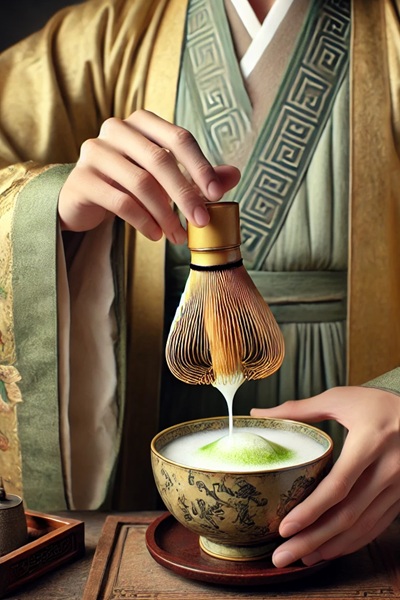Dian Cha (點茶): The Ancient Tea Art That Gave Birth to Matcha
Dian Cha (點茶): The Ancient Tea Art That Gave Birth to Matcha
Dian Cha (點茶): The Ancient Tea Art That Gave Birth to Matcha
When people think of “matcha,” they often associate it with the Japanese tea ceremony, known as Chanoyu or Sado (茶道). However, did you know that the whisking method of preparing matcha actually originated in China? This ancient tea practice is called Dian Cha (點茶), an art of tea preparation that flourished during the Song Dynasty and later influenced Japan’s tea culture.
What is Dian Cha?
Dian Cha (點茶) refers to the method of whisking powdered tea. Dried tea leaves, which were pressed into bricks, were ground into fine powder using stone mills and then mixed with hot water. A bamboo whisk was used to create a smooth, frothy texture—much like modern-day matcha preparation. This technique was especially popular during the Song Dynasty (960–1279 AD), enjoyed by emperors, scholars, and the aristocracy.
The Rise of Dian Cha in the Song Dynasty
Before the Song Dynasty, tea was typically brewed by boiling whole leaves, a practice that was common during the Tang Dynasty. However, in the Song era, tea preparation evolved: rather than boiling, tea was processed into dried bricks, ground into powder, and whisked into a frothy drink. This refinement of tea preparation elevated the experience, emphasizing both aesthetics and taste.
One of the most influential figures in promoting Dian Cha was Emperor Huizong of Song (宋徽宗, Zhao Ji), an avid tea enthusiast who wrote the Da Guan Cha Lun (大觀茶論), a treatise on tea culture during the Song Dynasty. His passion for tea helped establish Dian Cha as the pinnacle of tea refinement in China at the time.
From Dian Cha to Matcha: The Cultural Bridge to Japan
The art of Dian Cha was introduced to Japan through Zen Buddhist monks, who traveled to China and brought back tea seeds, cultivation techniques, and tea preparation methods, including the practice of whisking powdered tea. They also introduced tea utensils such as Jian Zhan (建盞), also known as Tenmoku (天目) in Japanese—a type of ceramic tea bowl prized for its dark glaze and aesthetic appeal.
One of the key figures in this exchange was the monk Eisai, who played a crucial role in establishing Japan’s tea culture. Over time, Dian Cha took root in Japan, eventually evolving into Chanoyu, the highly ritualized Japanese tea ceremony. By the 16th century, Japanese tea culture had developed its own distinct identity, guided by the teachings of Sen no Rikyu, who refined the aesthetics and philosophy of tea.
Why Did Dian Cha Disappear in China?
After the fall of the Song Dynasty, Dian Cha declined, especially following the Mongol conquest. With the rise of the Ming Dynasty (1368–1644 AD), Emperor Hongwu (Zhu Yuanzhang) encouraged a shift from powdered tea (associated with aristocracy) to loose-leaf brewing, which was simpler and more accessible. This transition ultimately led to the development of Gongfu Cha (工夫茶), the meticulous method of brewing whole tea leaves that remains popular in China today.
While China moved away from whisked tea, Japan continued to refine and preserve this practice. In a way, modern matcha is the living legacy of Dian Cha—a tradition that disappeared from its homeland but thrived abroad.
Dian Cha in the Modern Era
Although Dian Cha faded from Chinese tea culture for centuries, recent efforts have emerged to revive this lost tradition. Tea enthusiasts and historians are reintroducing Dian Cha in specialty tea houses, using newly crafted powdered teas to recreate the ancient experience. Additionally, the growing global appreciation for matcha has reignited interest in its historical roots, prompting a rediscovery of Dian Cha in China.
Conclusion
Dian Cha is the foundation of matcha, a tea preparation method that once flourished in Song Dynasty China but later disappeared—only to be preserved and refined in Japan. In many ways, Dian Cha is "the most ancient yet modern tea technique." Studying Dian Cha not only deepens our understanding of tea history but also reveals the intricate cultural connections between China and Japan.
So, if you ever have the chance, would you like to experience Dian Cha as it was enjoyed centuries ago? 🍵



